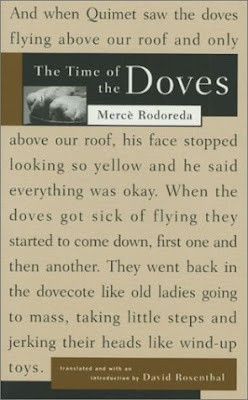The Time of the Doves
 According to the introduction (Graywolf Press edition, 1986)
Mercé Rodoreda started her career as a prolific writer with five novels by the age of about 28; by
1939 things changed dramatically. No only were Catalan books burned and Catalan
newspapers suppressed, but the author herself went into exile and felt
disconnected from her language and culture. In 1960, Rodereda returned to the
novel form and penned this stream of consciousness novel, in the voice of the
long-suffering Natalia from Barcelona. This is a life story which begins and
ends with courtship; of Natalia and Quimet, and much later with Natalia’s
daughter Rita and her love, Vincenḉ. This life cycle is interesting enough – on the basis of the close observations of domestic life and the
relationship between the married couple (with Quimet the domineering,
passionate kind – though not without interest in others). What makes it more
captivating is the way that the Spanish Civil War and its aftermath
enters the lives of the characters and changes their lives, seen from Natalia’s
point of view, far from any battle ground or city siege. We see the initial interruptions (charcoal
seller out of charcoal; milkman’s delivery ending; strikes and shortages).
Because Natalia has at this time a job cleaning the house of a more wealthy
family, we see the threat of the militia and there are stories of petty revenge
(while the wealthy family is portrayed not without criticism in terms of their
reported actions). Beyond this, churches are being burned and priests harassed
or worse, Quimet helps smuggle out of danger a local priest, while at the same
time joining the militia as a matter of immediate calling.
According to the introduction (Graywolf Press edition, 1986)
Mercé Rodoreda started her career as a prolific writer with five novels by the age of about 28; by
1939 things changed dramatically. No only were Catalan books burned and Catalan
newspapers suppressed, but the author herself went into exile and felt
disconnected from her language and culture. In 1960, Rodereda returned to the
novel form and penned this stream of consciousness novel, in the voice of the
long-suffering Natalia from Barcelona. This is a life story which begins and
ends with courtship; of Natalia and Quimet, and much later with Natalia’s
daughter Rita and her love, Vincenḉ. This life cycle is interesting enough – on the basis of the close observations of domestic life and the
relationship between the married couple (with Quimet the domineering,
passionate kind – though not without interest in others). What makes it more
captivating is the way that the Spanish Civil War and its aftermath
enters the lives of the characters and changes their lives, seen from Natalia’s
point of view, far from any battle ground or city siege. We see the initial interruptions (charcoal
seller out of charcoal; milkman’s delivery ending; strikes and shortages).
Because Natalia has at this time a job cleaning the house of a more wealthy
family, we see the threat of the militia and there are stories of petty revenge
(while the wealthy family is portrayed not without criticism in terms of their
reported actions). Beyond this, churches are being burned and priests harassed
or worse, Quimet helps smuggle out of danger a local priest, while at the same
time joining the militia as a matter of immediate calling.
The title comes from another passion of Quimet’s – that of doves.
He sets up a dovecote in the house and on the roof; Natalia is left to do most
of the work and comes to loathe the domination of the birds over her life. The
fate of the birds and her own intertwine, at least in terms of characterisation
and imagery: ‘And I took off. Higher, higher, Colometa … with my face like a
white blotch above the black of mourning …’ (p.151). There are several moments
of near madness for Natalia – such as a night when she walks the street with a
knife; otherwise she copes with the sort of fortitude and inner strength that drives
others to the extremes of faith or despair. This is an intimate portrait – not
of the Spanish Civil War directly – but exploring its profound effect of a good
woman’s life; a working-class woman who wants nothing more than safety, family,
and a little living. It helped me to understand something of the times through
this unique and yet very-relatable voice. It ends with ellipsis, which is not
to give anything a way but just to suggest the sort of novel it is – dealing
with moments mostly, but occasionally years …



Comments
Post a Comment